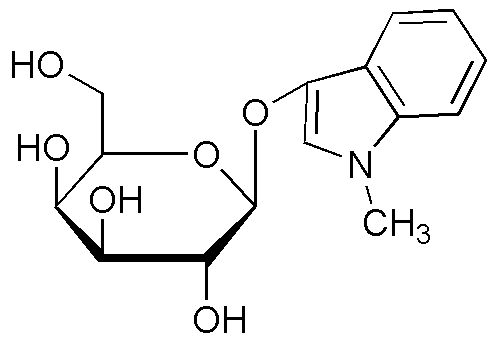N-Methyl-3-indolyl-b-D-galactopyranoside is widely utilized in research focused on:
- Biochemical Research: This compound is often used as a substrate in enzyme assays, particularly for studying beta-galactosidase activity, which is crucial in various biochemical pathways.
- Pharmaceutical Development: It serves as a valuable tool in drug discovery, particularly in the development of compounds that target specific biological pathways, enhancing the efficacy of therapeutic agents.
- Plant Biotechnology: Researchers apply this chemical to investigate its effects on plant growth and development, particularly in genetic studies involving indole compounds, which play a significant role in plant hormones.
- Diagnostics: It can be used in diagnostic assays to detect specific enzymes or metabolic pathways, providing insights into various diseases and conditions.
- Food Science: The compound is explored for its potential applications in food technology, particularly in flavor enhancement and preservation, leveraging its biochemical properties.
General Information
Properties
Safety and Regulations
Applications
N-Methyl-3-indolyl-b-D-galactopyranoside is widely utilized in research focused on:
- Biochemical Research: This compound is often used as a substrate in enzyme assays, particularly for studying beta-galactosidase activity, which is crucial in various biochemical pathways.
- Pharmaceutical Development: It serves as a valuable tool in drug discovery, particularly in the development of compounds that target specific biological pathways, enhancing the efficacy of therapeutic agents.
- Plant Biotechnology: Researchers apply this chemical to investigate its effects on plant growth and development, particularly in genetic studies involving indole compounds, which play a significant role in plant hormones.
- Diagnostics: It can be used in diagnostic assays to detect specific enzymes or metabolic pathways, providing insights into various diseases and conditions.
- Food Science: The compound is explored for its potential applications in food technology, particularly in flavor enhancement and preservation, leveraging its biochemical properties.
Documents
Safety Data Sheets (SDS)
The SDS provides comprehensive safety information on handling, storage, and disposal of the product.
Product Specification (PS)
The PS provides a comprehensive breakdown of the product’s properties, including chemical composition, physical state, purity, and storage requirements. It also details acceptable quality ranges and the product's intended applications.
Certificates of Analysis (COA)
Search for Certificates of Analysis (COA) by entering the products Lot Number. Lot and Batch Numbers can be found on a product’s label following the words ‘Lot’ or ‘Batch’.
*Catalog Number
*Lot Number
Certificates Of Origin (COO)
This COO confirms the country where the product was manufactured, and also details the materials and components used in it and whether it is derived from natural, synthetic, or other specific sources. This certificate may be required for customs, trade, and regulatory compliance.
*Catalog Number
*Lot Number
Safety Data Sheets (SDS)
The SDS provides comprehensive safety information on handling, storage, and disposal of the product.
DownloadProduct Specification (PS)
The PS provides a comprehensive breakdown of the product’s properties, including chemical composition, physical state, purity, and storage requirements. It also details acceptable quality ranges and the product's intended applications.
DownloadCertificates of Analysis (COA)
Search for Certificates of Analysis (COA) by entering the products Lot Number. Lot and Batch Numbers can be found on a product’s label following the words ‘Lot’ or ‘Batch’.
*Catalog Number
*Lot Number
Certificates Of Origin (COO)
This COO confirms the country where the product was manufactured, and also details the materials and components used in it and whether it is derived from natural, synthetic, or other specific sources. This certificate may be required for customs, trade, and regulatory compliance.


